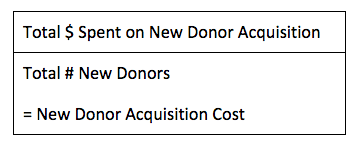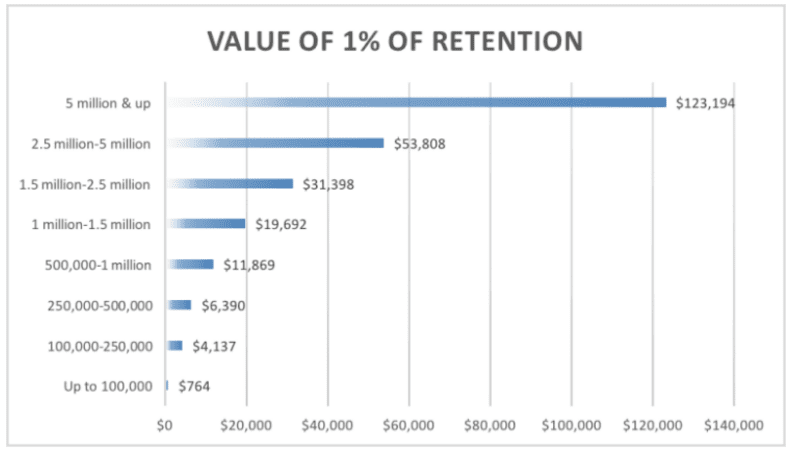Fundraisers spend a lot of time and money recruiting new donors to their nonprofits and charities. At first glance, you can’t deny that focusing some of your efforts on first-time donors is a great (and essential) strategy to bring fresh energy and new dollars to your cause.
At the same time, it takes a lot of resources to recruit and the return is statistically quite low. In fact, it can take upwards of 2 or more years to recoup typical donor acquisition costs.
This is why the Fundraising Effectiveness Project (FEP), a joint project between the Association of Fundraising Professionals and the Urban Institute, is so helpful for development professionals. This annual report gives us a thorough look at current donor retention trends to help us develop new strategies for retention and engagement.
Download your donor retention calculator template below:
Not surprisingly, the 2015 FEP reported that 19% of first-time donors were retained by nonprofits, compared with 63% of repeat donors.
What does this mean for your nonprofit? It suggests that your first priority should be retaining your current, active donors.
Before we dive into calculating your rate, let’s look at some donor retention basics.
“Your first priority should be retaining your current, active donors.” tweet this
What Is Donor Retention?
Donor retention refers to the number (or percentage) of donors that return to give another gift in a specific time period. Most nonprofits and charities measure donor retention year over year.
Why Is Donor Retention Important?
A high retention rate indicates that a nonprofit has a healthy support system. Here are some other reasons why donor retention is so important to nonprofits and charities.
- Donor Acquisition Costs Are High: Nonprofit professionals focus on donor retention because of the high initial cost of recruiting first-time donors. As mentioned above, it can take 18-24 months for nonprofits to recoup the amount of money they spend to attract a first-time donor, as most gifts are generally 2 to 3 times less than the marketing/recruiting cost.
- Gain Access To Bigger Networks With People Fundraising: If you’ve impressed your donor enough to warrant repeat donations, then there’s a chance that donor may be recommending your cause to friends and family—which is the basis of People Fundraising. Thus, that relationship is leveraging additional donations.
- Potential For Larger Gift Amounts: The 2015 FEP found a direct correlation between retention and gift size. Returning donors of gifts less than $100 were retained at 53% while retention was 76% for those gifting $250 or more. This could mean that as your nonprofit grows along with your donor, their gifts are likely to increase over time.
Now that you know more about donor retention, it’s time to establish your retention baseline. If you haven’t been tracking donor retention, then now is the perfect time to start. Follow these steps:
“If you haven’t been tracking donor retention, then now is the perfect time to start.” tweet this
Measuring Donor Retention
1. Capture The Data
It’s impossible to calculate your retention rates without tracking your donors and gifts. While there are a number of ways to do this, remember that the decision to use one method over another is determined by your nonprofit’s size and resources.
- Donor Management Software: Nonprofits of all sizes can benefit from using a donor management software platform. These programs track donor information, gift amounts, and interactions.
- Your Fundraising Platform: Depending on the online fundraising platform you use(i.e. CauseVox), you may be able to track individual donor information along with overall trends right on your dashboard.
- Spreadsheet: Smaller operations sometimes use a simple Excel spreadsheet to track donations. This method may seem primitive, but for those without the financial or technological means to purchase a program, it’s a good first step.
Make a concerted effort to track as much information as you can on your donor in real-time so you’re not just storing it all in your head for a later day. The more accurate your data is, the better you can accommodate donor trends year after year.
2. Make Your Initial Retention Calculation
To figure out your retention rate, follow this formula:

For example, if 100 donors from last year returned to give gifts again out of 250 total donors, you retained 40% of your donors and lost (attrition) 60%.
100/250=.4 (40% retained)
Download your donor retention calculator template below:
3. Dive Into Your Data
Donor retention focuses the number of donors that come back year after year, but there are other data subsets to consider.
We suggest you dig deeper and learn more about your donor base by also calculating the following:
First-time Donor Retention
The number of first-time donors giving a second gift.

Because of the FEP we know that, on average, only 19% of first-time donors give another gift. Thus, if your percentage is higher than this than you’re retention and engagement strategies are on the stronger side.
A low percentage means that you’re not keeping donors interested in your cause. In this case, analyze the steps you take to engage your first-time donors and incorporate donor engagement and retention best practices featured later in this post.
Returning Donor Retention
The percentage of donors giving 2 or more gifts that give again.

Remember that, for the average nonprofit, roughly 63% of returning donors give another gift. Again, if your rates are at or around 63%, then your efforts are working. If you find that your retention rate is lower than this benchmark, focus on ways to improve your efforts.
Average Annual Gift
When analyzing your donor retention rates, it may also help your organization to look at average annual gift amounts. Any changes, particularly negative ones, indicate you should refocus your efforts on increasing gift amounts by incorporating recurring giving campaigns, and major gift efforts, etc.
By comparing the average annual gift amount of year #1 to the average annual gift amount from year #2, you can also learn whether your average gift size is growing or decreasing alongside your retention rate.
Lifetime Value
The monetary amount you can expect from the average donor.

Yes, the cost to acquire a new donor is high. Couple that with statistically low first-time donor retention rates, and it’s safe to say that recruiting and keeping a donor is difficult. When you perform the Lifetime Value (LV) calculation, you can clearly see how much your average donor will give over the course of your relationship.
Let’s say your average annual gift is $100 and your attrition rate is 50%. You can assume your average donor will give $200 to your organization ($100/.5=$200).
Now, consider a lower attrition rate of only 25%. Even with an average annual gift of $100, an average donor will give a considerably higher amount of $400 ($100/.25). Wow!
Donor Acquisition Costs
The cost to recruit each new donor.

We suggest you track donor acquisition costs to get a clear picture of how much you’re spending per new donor.
For example, if you spent a total of $20,000 to bring in gifts from 150 new donors this past year, your donor acquisition cost was $133.33 ($20,000/150=$133.33).
But what if your average gift was only $100? Then you’re actually losing money bringing new donors in.
When all’s said and done, the key factor in the success of your fundraising efforts is donor retention. And as you can see from the 2015 FEP report chart below, even a 1% increase in retention pays!

The Ideal Scenario
In a perfect world, you’ve captured accurate data for as many years as you’ve been collecting donations and your donor information is up-to-date. And then, when you calculate your retention rate, it’s always an impressive 70-100%.
But in reality, donor and gift tracking can get messy, especially if multiple people manage the data in *gasp* different locations. That’s why it is so important to commit to a system of tracking your donor information and stick to it, no matter the circumstances.
On thing to keep in mind is that there’s no “one-size fits all” when it comes to retention rates, as they can vary for a million and one reasons (size of your nonprofit, economic issues, fundraising budget, etc.)
Just focus on your own numbers. As you track your returning donors, you’ll get a good idea of where you are starting from and you can work from there to improve.
“Donor tracking software can help ensure you don’t forget to ask each and every donor.” tweet this
Expert Tip: Don’t get hung up on other organization’s retention rates. Determine your benchmark and then work forward.
8 Essential Tips For Effective Donor Retention
Donor engagement leads directly to retention. So, keep your donors consistently flowing through the donor engagement cycle to continue to strengthen your numbers.

Here are 8 tips to use that will inspire, activate, and rally your supporters and ensure retention.
1. Personalize The Giving Experience
Show your donors how much they matter to you by speaking directly to them. Here are a few suggestions:
- Refer to each donor by their name. Avoid generic greetings.
- Acknowledge the donor’s last gift amount and your history together, especially when asking for another gift
- Learn about your donor’s interests and communication preferences and use this information to tailor messages about donor impact and upcoming engagement opportunities.

If you remember that your donors aren’t just a number, you’re on the right track to higher retention.
2. Inspire Through Education
Keep donors informed about WHY their gift matters.
- Share nonprofit stories about those impacted by your organization’s work
- Use powerful images and videos to educate your social media followers
- Include information in your communications that is relevant and useful for your supporters. If your donor thinks your content is of use, they’re more likely to share it with others.
As a reminder, keep your website, online fundraising pages, and all social media pages clean and organized with current information to help your donors easily find the information they’re looking for.
3. Engage Donors With Activities
There’s a good chance that if that supporter is donating, there is something about your cause that resonates with him/her. Use this knowledge to cater personalized opportunities for engagement that help develop a strong relationship. Engagement takes many forms such as:
- Volunteering
- Advocating for your cause
- Serving as a board member
- Connecting you with others interested in the cause
- Networking
- Fundraising
Don’t think of your donors as simply a vehicle for donations. Instead, think of them in a holistic way as a “supporter” and give them opportunities to get involved on many levels.
4. Activate Supporters
A sure-fire way to retain supporters is to activate them. When supporters get out there and “do something” for your organization, they’re helping you out while also becoming further invested in your nonprofit or charity.

Consider running a peer-to-peer fundraising campaign and recruit donors to become personal fundraisers. Use CauseVox to power your online fundraising campaign and track the efforts of your loyal, active supporters.
5. Don’t Forget To Ask Again
By the time your next fundraising campaign rolls around, your donors will be expecting another ask. If you overlook your donors, especially your first-time donors, they may not give again down the road.
Donor tracking software can help ensure you don’t forget to ask each and every donor.
“Donor tracking software can help ensure you don’t forget to ask each and every donor.” tweet this
6. Thank Your Donors Immediately & Often
Here at CauseVox, we love to talk about thanking donors. In fact, it is one of our favorite topics because we believe it is THAT important. Here are a few ways you can thank your donors:
- Send them an immediate donation receipt with a thank you after they make a gift. If you use CauseVox, you can set up your account so it produces this donation receipt automatically.
- Handwritten thank you letter
- Video thank you (email)
- Social media shout out (if anonymity isn’t an issue)
- Phone call
While it’s absolutely necessary to thank your donors after they’ve made a gift, this shouldn’t be the only time you do it. Don’t forget to reach out to your donors at other key times of the year including Thanksgiving and New Year’s Eve.

7. Report Results
Donor’s don’t just need, they deserve and expect, evidence that their gift had an impact. There are many ways to report results to supporters, including:
- Impact reports
- Newsletters
- Annual Report
- Infographics and statistics shared on social media and email
You speak to your donor’s heart constantly through stories and images and invoke emotion. Data reporting is a good way to balance all that “heart” with the mind.
8. Surprise Your Donors When They Least Expect It
We are greatly inspired by Watsi’s email marketing and recurring giving efforts, but the one thing that stands out most is Watsi’s commitment to providing donors with a touch of the unexpected. As a surprise, Watsi mailed their recurring donors a beautiful book of photos from their fieldwork.
If you can, try to add an element of surprise to keep your supporters interested in your cause and eager to see what you come up with next. Whether you decide to send out a heartwarming video, make a random call just to say “thanks,” or host a donor appreciation luncheon—the point is that you’ve made a concerted effort to show your donors how much they matter.
As you can see, donor retention has a huge influence on an organization’s bottom line. A high retention rate can lead to a decrease in fundraising costs, more engagement, and referrals. But measuring retention is only possible if you’re prepared. So start tracking donor information now with a platform that is right for your nonprofit. Once you have the data, incorporate retention and engagement techniques to increase your rates and keep your donors coming back.
Here are more resources that may be useful to you as you analyze your donor retention rates:
Editor's Picks
Ultimate Guide To Peer-to-Peer Fundraising
Customer Story: Spur Local Raises Over $1M With Their Give Local Campaign
Fundraising Strategies for Nonprofits: Craft the Best Approach for Your Organization
Create a Killer Fundraising Plan - Best Practices, Strategies, & Downloadable Template




